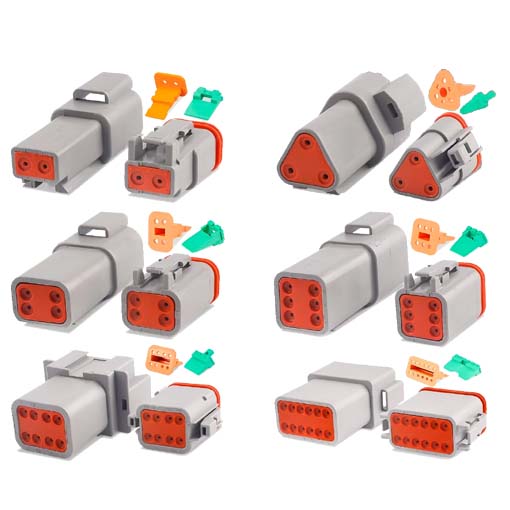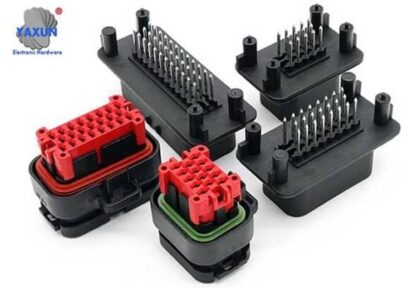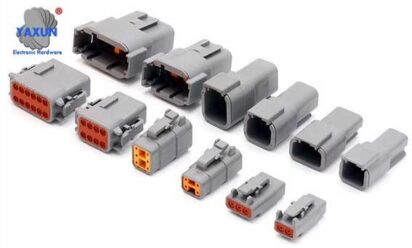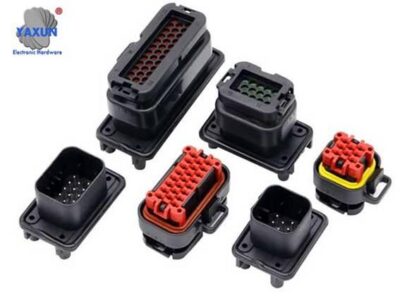The automotive connector products of ECT are mainly Fakra board terminal & cable terminal, HSD board terminal & cable terminal, HD Camera connector, car USB, etc.. It is mainly used in various OEMs and TIER 1 customers for RF connection and HD connection.
Automotive connectors are a component that electronic engineers and technicians often come into contact with. Su función es muy sencilla: to build a bridge of communication between blocked or isolated circuits in the circuit, so that the current can flow and the signal can be transmitted as intended. The form and structure of automotive connectors are ever-changing. It is mainly composed of four basic structural components, namely: contact plug-in, shell (depending on the variety), insulator, and accessories. In the industry, it is usually also called sheath, conector, and plastic case.
About Automotive Connectors
Hay casi cien tipos de conectores utilizados en los automóviles en general., y hay cientos de conectores utilizados en un solo modelo. A medida que las personas tienen requisitos cada vez más altos para los automóviles en términos de seguridad, protección del medio ambiente, comodidad, e inteligencia, La aplicación de productos electrónicos automotrices está aumentando.. Esto conducirá a un aumento en el número de aplicaciones de conectores para automóviles..
Basic structure of automotive connectors
Four basic structural components of automotive connectors
1. Contact pin: It is the core part of the automotive connector to complete the electrical connection function. Generalmente, a contact pair is composed of a male contact pin and a female contact, and the electrical connection is completed through the insertion of the female and male contact pins.
Male contact pins are rigid parts that can be cylindrical (round pins), square cylinders (square pins) or flat (blades). Male contacts are generally made of brass, bronce fosforado. The female contact is the socket, which is the key part of the contact pair. It relies on the elastic structure to elastically deform when it is inserted into the pin to generate elastic force and form a close contact with the male contact to complete the connection. There are many types of socket structures, including cylindrical pin holes (splitting, shrinking), tuning fork type pin holes, cantilever beam type pin holes (longitudinal slotting), folding pin holes (longitudinal slotting, 9-shaped) , box-shaped pin holes (square jacks) and hyperboloid wire spring jacks, etc..
Second, the connector shell (shell): It is the outer cover of the automotive connector, which provides mechanical protection for the built-in insulating mounting plate and pins, and provides alignment when the plug and socket are mated. This in turn secures the connector to the device.
3. Connector insulator: The insulator is also often called the base or insert of the car connector. Its function is to arrange the contacts according to the required position and spacing, and to ensure the insulation performance between the contacts and between the contacts and the shell. Good insulation resistance, withstand voltage performance and ease of processing are the basic requirements for selecting insulating materials to be processed into insulators.
Fourth, connector accessories, accessories are divided into structural accessories and installation accessories. Structural accessories such as collars, positioning keys, positioning pins, guide pins, coupling rings, cable clamps, sealing rings, gaskets, etc.. Installation accessories such as screws, nuts, screw rods, spring rings, etc.. Most of the accessories have standard parts and general parts.
It is these four basic structural components that enable the automotive connector to act as a bridge and operate stably.
 English
English العربية
العربية Български
Български 中文(漢字)
中文(漢字) Čeština
Čeština Dansk
Dansk Eesti keel
Eesti keel Suomi
Suomi Français
Français Deutsch
Deutsch Ελληνικά
Ελληνικά עברית
עברית Magyar
Magyar Bahasa Indonesia
Bahasa Indonesia Italiano
Italiano 日本語
日本語 한국어
한국어 Latīna
Latīna Latviešu valoda
Latviešu valoda Lëtzebuergesch
Lëtzebuergesch Polski
Polski Português
Português Română
Română Русский
Русский Slovenščina
Slovenščina Español
Español Svenska
Svenska ภาษาไทย
ภาษาไทย Tiếng Việt
Tiếng Việt






